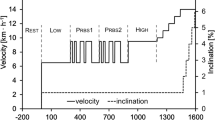Summary
The relationship of maximal oxygen uptake\((\dot V_{O_2 } \max )\) and resting oxygen uptake in two seasons of the year (winter/summer) was investigated in 119 young males. The subjects were conscripts, who were investigated at the calling-up time (winter:n=58). The two groups were comparable with respect to their anthropometric data and smoking habits, as well as their occupational and leisure time activities.\(\dot V_{O_2 }\) max was significantly (p<0.01) higher in the subjects investigated in the summer time (3.35 l/min) compared with those in the winter time (3.12 l/min). There was no difference in resting\(\dot V_{O_2 }\) expressed relatively to body weight, whereas the resting\(\dot V_{O_2 }\) was significantly (p<0.05) higher in winter than in summer, when it was expressed relatively to lean body mass and body surface area. The results suggest that seasonal variation in maximal aerobic power may occur in young males; this may in turn affect their response to physical training.
Similar content being viewed by others
References
åstrand P-O, Rodahl K (1977) Textbook of work physiology. 2nd edn. McGraw-Hill Book Company, New York
Bogin BA (1978) Seasonal pattern in the rate of growth in height of children living in Guatemala. Am J Phys Anthropol 49: 205–210
Bradley JV (1968) Distribution-free statistical tests. Prentice-Hall, New Jersey
Du Bois D, Du Bois EF (1916) A formula to estimate the approximate surface area if height and weight be known. Arch Intern Med 17: 863–871
Gollnick PD, Armstrong RB, Saubert IV CW, Piehl K, Saltin B (1972) Enzyme activity and fiber composition in skeletal muscle of untrained and trained men. J Appl Physiol 33: 312–319
Gray RS, Duncan LJP, Clarke BF (1979) Seasonal onset of insulin dependent diabetes in relation to sex and age at onset. Diabetologia 17: 29–32
Ingemann-Hansen T, HalkjÆr-Kristensen J (1977) Cigarette smoking and maximal oxygen consumption rate in humans. Scand J Clin Lab Invest 37: 143–148
Ingemann-Hansen T, HalkjÆr-Kristensen J (1978) Effect of tobacco smoking on the fibre composition in the human skeletal muscle. Scand J Rheumatol 7: 139–140
Inoue K (1972) Seasonal change in farmers' working and sleeping hours. J Hum Ergol (Tokyo) 1: 19–28
Keys A, Taylor HL, Grande F (1973) Basal metabolism and age of adult man. Metabolism 22: 579–587
Kuroshima A, Doi K, Ohno T (1979) Seasonal variation of plasma glucagon concentrations in men. Jpn J Physiol 29: 661–668
Matsui H, Shimaoka K, Miyamura M, Kobayashi K (1978) Seasonal variation of aerobic work capacity in ambient and constant temperature. In: Folinsbee LJ, Wagner JA, Borgia JF, Drinkwater BL, Gliner JA, Bedi JF (eds) Environmental stress, individual human adaptations. Academic Press, New York, pp 279–291
Ramirez-Lassepas M, Haus E, Lakatua DJ, Sackett L, Swoyer J (1979) Seasonal (circannual) periodicity of spontaneous intracerebral hemorrhage in Minnesota. Ann Neurol 8: 539–541
Sloan AW, Koeslag JH, Bredell GAG (1973) Body composition, work capacity and work efficiency of active and inactive young men. Eur J Appl Physiol 32: 17–24
Sloan AW, Weir JB de V (1970) Nomograms for prediction of body density and total body fat from skinfold measurements. J Appl Physiol 28: 221–222
Smals AGH, Ross HA, Kloppenborg PWC (1977) Seasonal variation in serum T3 and T4 levels in man. J Clin Endocrinol Metab 44: 998–1001
Smith JM, Springett VH (1979) Atopic disease and month of birth. Clin Allergy 9: 153–157
Turek FW, Campbell CS (1979) Photoperiodic regulation of neuroendocrine-gonadal activity. Biol Reprod 20: 32–50
Wilhelmsen L, Tibblin G, Fodor J, Werkö L (1971) A multifactorial primary preventive trial in Gothenburg, Sweden. In: Larsen OA, Malmborg RO (eds) Coronary heart disease and physical fitness. University Park Press, Baltimore, pp 266–270
Yoshimura M, Yukiyoshi K, Yoshioka T, Takeda H (1966) Climatic adaptation of basal metabolism. Fed Proc 25: 1169–1174
Author information
Authors and Affiliations
Additional information
Supported by grants from the Danish National Association Against Rheumatic Diseases and the Danish Council for Sports Research
Rights and permissions
About this article
Cite this article
Ingemann-Hansen, T., HalkjÆr-Kristensen, J. Seasonal variation of maximal oxygen consumption rate in humans. Europ. J. Appl. Physiol. 49, 151–157 (1982). https://doi.org/10.1007/BF02334063
Accepted:
Issue Date:
DOI: https://doi.org/10.1007/BF02334063




